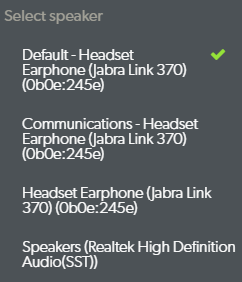If you experience technical issues during a video call, refer to this troubleshooting poster before checking below.
Still having issues? Click on a tab below for more in-depth troubleshooting information and tips relating to the issue you are experiencing:
 Speakers (Can't hear others)
Speakers (Can't hear others)
- If you have external speakers or headphones ensure they are securely plugged into your computer or mobile device.
- Ensure the volume on your computer or mobile is turned on and set to an audible level.
- Tell the other person you can’t hear them and ensure they aren’t muted. They may need to check their sound input (microphone) settings.
- Try playing a YouTube video to check that your speakers are actually working.
- If you have multiple speakers/headsets connected to your device, has the correct one been selected? From within a Video Call screen, here is how to check:
 Click on the settings icon in a video call screen to select the required speaker from the Select speaker dropdown. This change only affects the current call. |
Desktop computer:
Mobile Example (Android and iOS): You should see the default being selected
|
If you are no longer in a call and using a windows PC (Windows Operating System), try this to check your speaker settings (audio output):
|
Windows 10: At the bottom of the taskbar, click on the speaker icon and check your settings. If you have more than one speaker or headset connected, select the speaker you would like as the default from the drop-down list of playback devices. |
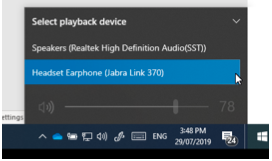
|
|
Windows 8 and 7: At the bottom of the taskbar, click on the speaker icon and check your settings. |
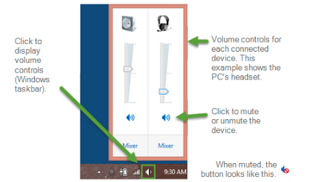 |
If using a Mac and no longer in a call, try this to check your speaker (audio output) settings:
|
MacOS: Click on the speaker icon at the top right of your screen and select the preferred speaker from the available sound output options. |
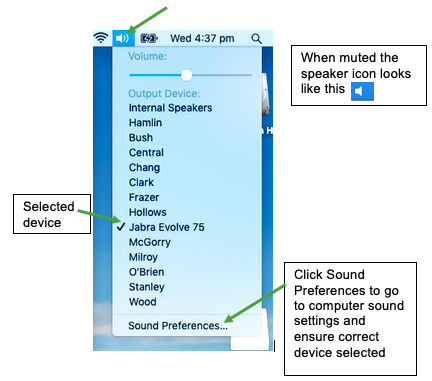 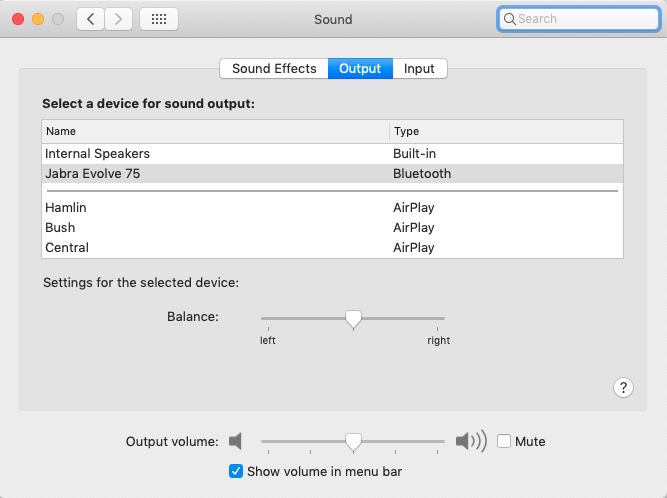
|
Hearing an Echo?
Microphones and speakers, if not properly set up, can cause an echo during your call. An echo is most often produced when the microphone picks up the sound of the speakers.
- If you are using external speakers, position the speakers away from your laptop microphone and try reducing the volume.
- If you are using an external microphone move it further away from your speakers.
- If available, try using a headset or headphones instead of speakers and microphones if the above suggestions don't work.
 Microphone (Others can't hear me)
Microphone (Others can't hear me)
- Conduct a Test call (Precall test) to ensure the platform can access your microphone.
- Ensure your microphone is not muted in your video call screen.
- If using an external microphone ensure it is firmly plugged in. Try unplugging it and plugging it back in again as this forces your computer to detect it.
- Ensure your microphone is not muted and the volume is set adequately, especially if you have volume control on your external headset.
- Ensure there is no other software such as Skype or a video conferencing client running on your device and using your microphone. It is best to completely close all these other applications when you are using Video Call.
- Has the correct microphone been selected? There are three places you can check your microphone settings:
1. From within the video call
|
Click on the settings icon and select a different microphone from Select microphone. This change only affects the current call. |
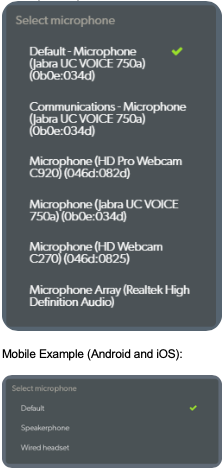 |
2. Browser microphone settings
If you are no longer in a call, you can view and set your microphone settings in your Chrome browser:
| 1. In a Google Chrome browser, open a new tab and in the address bar enter: chrome://settings/content/microphone. Google Chrome's Microphone settings page opens. You can check if any sites are blocked from using your mic here and can select allow for a particular site. |
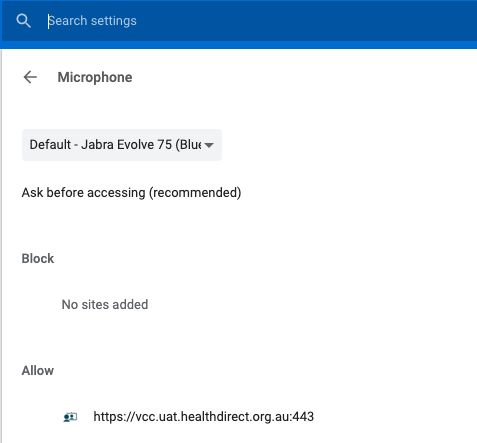 |
| 2. Select the microphone you want as your default from the drop-down list. | 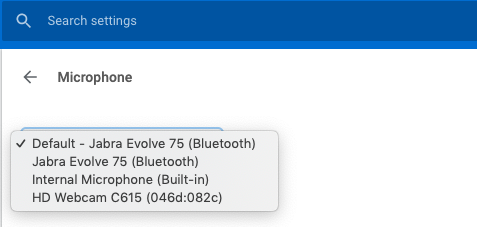 |
| Please note that you can also click on the small camera icon at the top right of your call screen to see the camera and microphone being used by browser. |
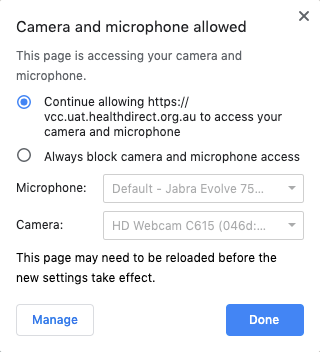 |
Go to your computer's audio settings where you can check the microphone currently selected and change if you have more than one available:
| On a Windows PC go to Search in your task bar and type ‘Sound’. Select the required microphone in sound settings. | 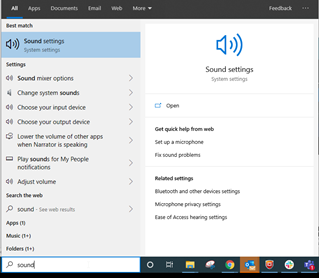 |
| On a Mac go to System Preferences and click on Sound. Click on Input and check the correct microphone is selected. |
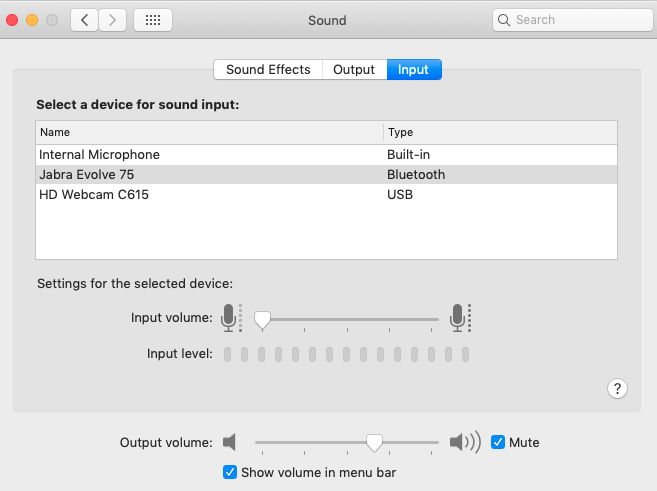
|
Microphone tips:
If you still cannot be heard clearly, this could be due to additional noise like fan noise from your computer, background noise in the room, feedback from your speaker audio being picked up by your microphone, or just being too far away from the microphone.
- Ensure your microphone is not muted.
- If you have an external USB web camera, its microphone will likely be better than an inbuilt one and pick up less noise from the computer.
- If you have a headset with a microphone, it will provide the clearest audio with the least background noise.
- If you have a USB echo-cancelling combined microphone/speaker unit, make sure it is selected for use as both the microphone and speaker.
 Camera (Can't see)
Camera (Can't see)
- Conduct a test call/precall test to see if your camera can be accessed by the video call platform.
- If you have an external camera plugged in, eg a USB camera, ensure that it is plugged in correctly.
- Ensure your camera is working if it is an in-built camera in your PC/Mac/mobile device.
How do I do this?
If using a Windows PC:
If using a Mac:On a Windows PC go to Search in your task bar and type ‘Camera’. The camera app will open and you will see your camera image – you can switch cameras if you have more than one available. Make sure you can see yourself. 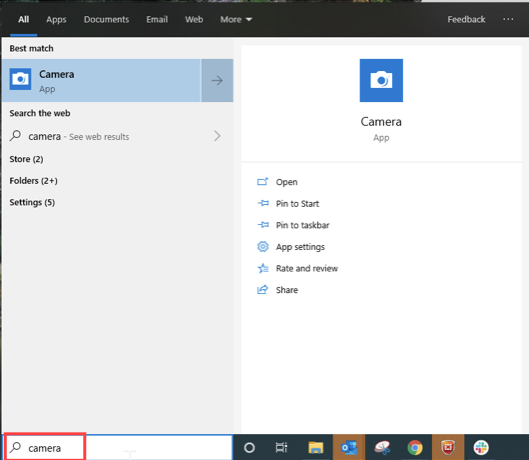
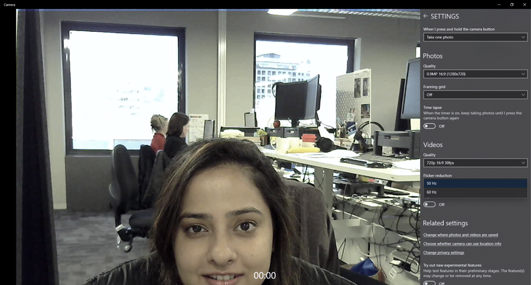
On a Mac open the Photo Booth application and make sure you can see yourself. 
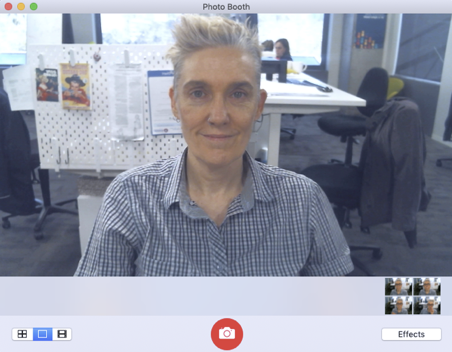
- If you are using an external camera like a USB camera, ensure it is firmly plugged in and detected by your computer. Tip: Unplug the camera and plug it in again. This forces your computer to try and detect it again.
- Ensure there is no other software such as Skype or a video conferencing client running on your device and using your camera. It is best to completely close all these other applications when you are using Video Call.
- Have you selected the correct camera? If your camera is not showing you but showing somewhere else in the room, ensure you have selected the correct camera from within your Video Call screen.
Desktop computer Click on the settings icon at top left in your video call screen to select a different camera from the Select camera dropdown. Click on the settings icon at top left in your video call screen to select a different camera from the Select camera dropdown. |
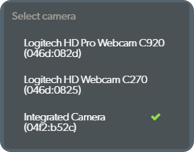 |
|
Mobile device Click on Switch camera and select the desired camera. |
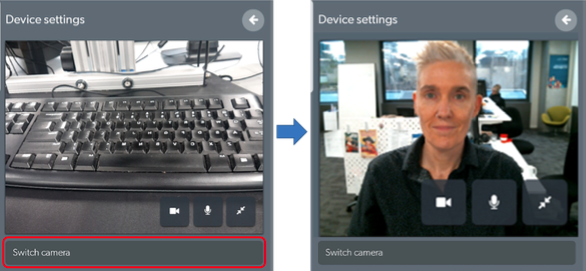 |
Click here for instructions to follow if your camera is blocked by the browser for the Healthdirect Video Call site.
If you are still experiencing camera issues restart your browser and, if the issue persists, restart your device.
Experiencing camera flicker?
If your camera is flickering, ensure there is enough light in your surroundings and, if the flicker continues, ensure that your camera is operating with 50 Hz flicker reduction. You can ensure this is the case by typing Camera in your Windows bar as below and ensuring you have Flicker reduction set to 50Hz. Tip: change to 60 Hz and change back to 50 Hz to ensure that this setting took effect.
Windows 10 Example:
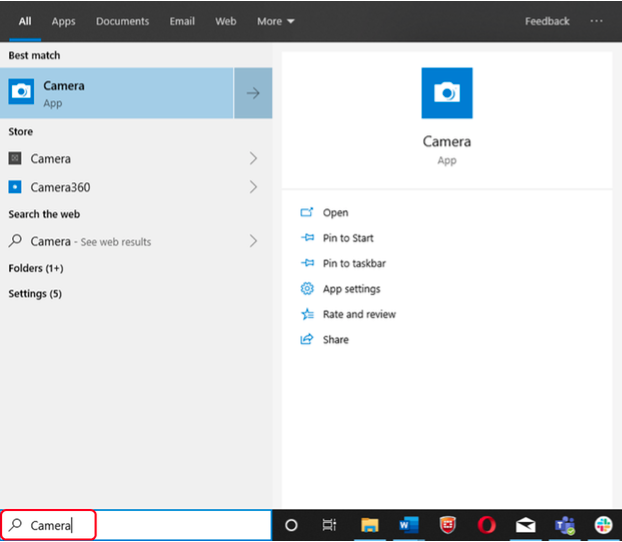
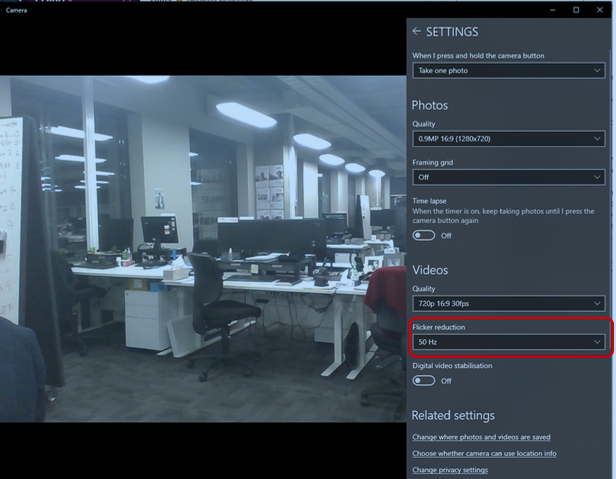
Video tips:
If your image is dark, this may be because there is a bright light behind you (eg sitting in front of a window). If possible, have the light to one side, or in front of you, behind the actual camera location. This will allow the person at the other end to see you better. Tip: Make sure that there are no bright lights or windows that the camera can see. Most will be behind you, but if your web camera has a wide field-of-view, this may also include a light source to your left or right.
 Internet connection issues
Internet connection issues
To make a successful video call, you need an internet connection that sends and receives data quickly enough, so latency should not be more than 100 milliseconds. A good broadband connection is required (minimum speed is 350Kbps upstream and downstream for Video Call).
Traffic Light connection feature
You can easily check your call connection speed while in a Healthdirect Video Call.
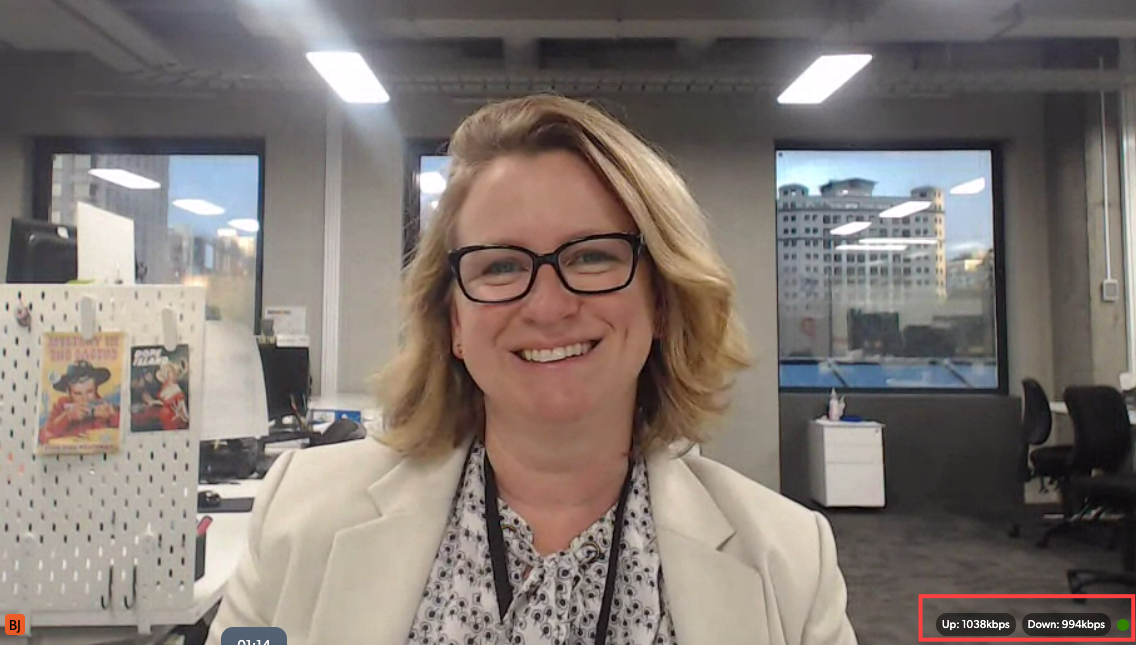

- When you enter a video call you will see a coloured dot at the bottom right of the other participant screens.
- This traffic light feature indicates the quality of your internet connection with each connected participant.
- Green is good, yellow is ok, red is bad.
- Click the traffic light to see the actual bandwidth with which you are connected to them - anything below the required 350Kbps up or down will lead to drop-outs
You can do also do a speed test here: https://www.speedtest.net/
If using your mobile phone or tablet, 3G/4G mobile signal should be adequate for Video Call.
Below is more technical information relating to your video call connection. If you are using your organisation's internet (wifi or wired connection) this is useful information for your IT department.
Connection Issue message
- Attempted to join a call and been presented with a 'There is an issue with your connection' message?
- Issues during a call and been presented with 'A connection issue has been detected' message?
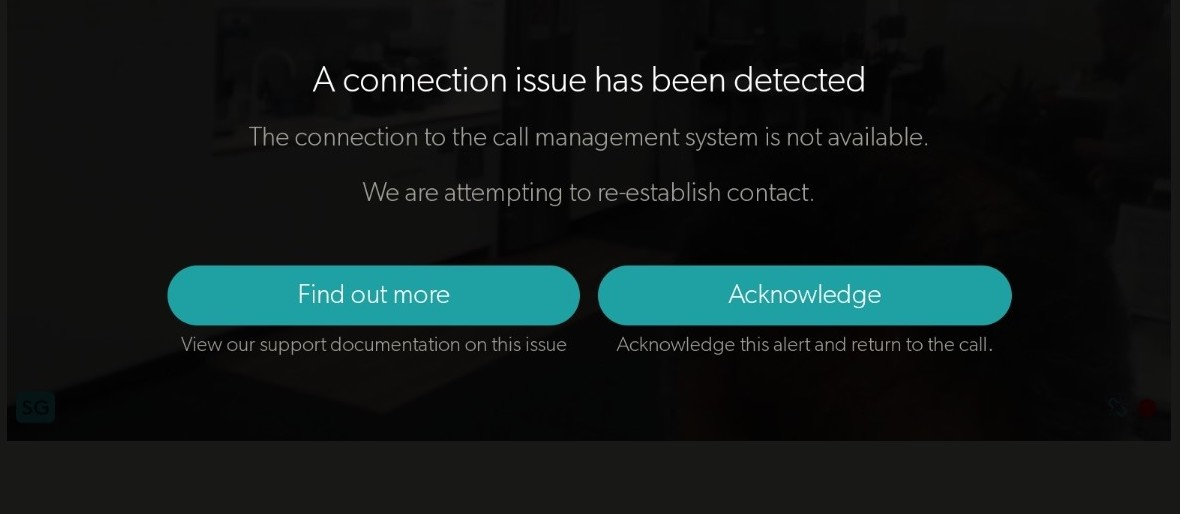
Causes |
Solution |
|
Not connected to the Internet If your Internet connection has dropped out, or for some other reason become unavailable, then Video Call will detect this and display the notification. In this instance, restoring your connection will result in this error automatically resolving itself. If you are travelling while using Video Call, you may experience this error when your mobile device changes between cellular towers, or when entering areas of low/no service (such as tunnels). |
When a drop out occurs, Video Call immediately begins to restore your connection. If your Internet connection is restored, Video Call will pick this up and restore your call. You can also press the Refresh button once your internet connection is restored. |
Signaller Connectivity warning
Joined a call and have been presented with the 'Signaller Connectivity' warning?
| Causes | Solution |
Behind a proxy or firewallVideo Call uses a technology known as WebSockets for our call orchestration. While a standard, and highly prevalent web technology, some network architectures include proxies and/or firewalls that can block the necessary connection upgrades required for WebSockets to work, and result in an inability to connect to our Video Call infrastructure. |
Check with your IT department that the network rules (if you are a hospital or large health organisation) are maintained as below:
An alternative solution is to use another network - such as a 4G phone/mobile broadband connection to connect to your call. |
Interference from Antivirus SoftwareSimilar to the above section, some Antivirus software can interfere with the establishment of a WebSockets connection. |
If you are experiencing interference from your Antivirus Software, you may be able to add an exception for videocall sites (https://*. vcc.healthdirect.org.au) for your Antivirus to allow WebSockets to work. If you are within a corporate network, this may require the assistance of your network administrator. |
Interference from a VPNIf you have a company provided laptop or desktop computer that has VPN capability, it may cause issues connecting with healthdirect Video Call. You may get a message saying 'this website is unavailable'. |
First try to complete a precall test with your VPN disconnected. If you are unable to connect to the precall test page, please ensure your IT Team whitelists the following addresses on the Proxy Server: *vcc.healthdirect.org.au* *vcc2.healthdirect.org.au* For many VPN connections, allowing NAT egress to UDP port 3478 on the relay server (vcct.healthdirect.org.au) will also be required. |
Other participant never appears in your video call
When trying to connect to another person, they never appear or it just says "is being connected" but the connection doesn't happen.
| Causes | Solution |
When trying to connect to another person, they never appear in your Video Call window.Analysis: you are not connecting to the Coviu signalling server, which is connecting up the endpoints to each other via Websockets. |
Recommended option: Please run a pre-call test. The results will advise you of actions to take to optimise your network connectivity. For many networks, allowing NAT egress to UDP port 3478 on the relay server (vcct.healthdirect.org.au) will provide low latency with little overhead. This should require only a minor, low-risk change to your network configuration. For more information, please visit Media Pathways |
There are things you can do to improve the quality of your existing connection for better video calling:
- Wireless home or office network - Try moving closer to, or at least in line-of-sight of, the WiFi base station.
- Mobile internet connection - Try moving to an area with better reception, you can check how many bars you have on your device.
- If your internet connection has limited speed, make sure that no one else in your home is using the same internet connection at the time you are making the video call. Typically, streaming video or downloading large files can choke your internet if you are multi-tasking. This will substantially reduce the bandwidth available to make a good quality video call.
- Make sure that you don’t have more than one connection to the internet active at the same time (for example, a wired and a wireless connection running at the same time)
- Make sure that you have not used all of your internet plan’s data allocation for the month. This often results in your internet provider reducing the speed of your service after you’ve exceeded the data limit.
- When you first switch on your computer after not using it for a while, it may automatically download updates, similarly with Android and iOS updates. This will reduce available bandwidth. Either wait for the updates to finish or postpone the downloads until after you have made your video call.
If the troubleshooting steps above do not solve your issues please contact your local Telehealth support and they will assist and escalate further if required.
